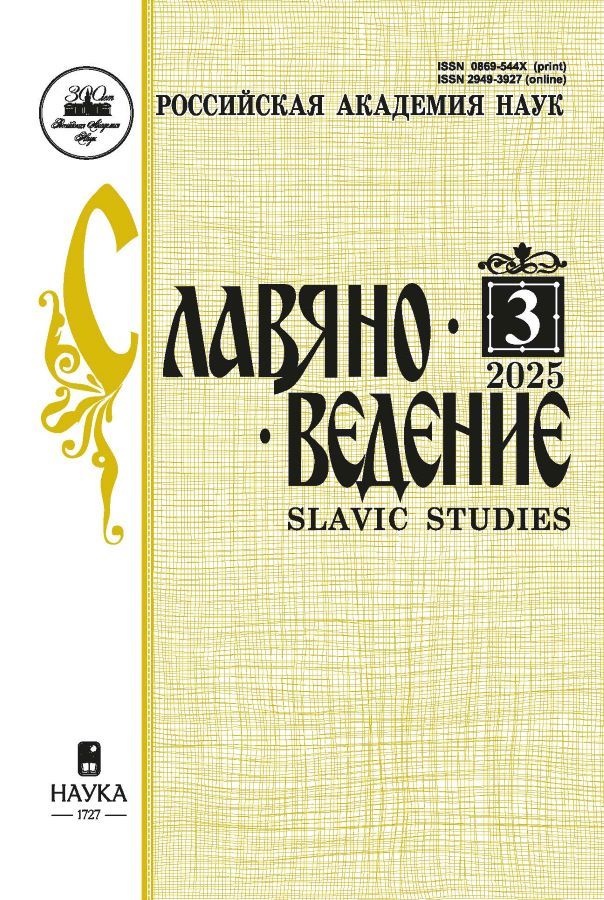Syntactic Constructions with Coordinating Conjunctions in Homilies of Kirill of Turov. 1.
- 作者: Makeeva I.I.1
-
隶属关系:
- Vinogradov Russian Language Institute of Russian Academy of Sciences
- 期: 编号 3 (2025)
- 页面: 93-107
- 栏目: To the centenary of V.N. Vinogradov and G.L. Arsh
- URL: https://vestnik.nvsu.ru/0869-544X/article/view/686479
- DOI: https://doi.org/10.31857/S0869544X25030074
- EDN: https://elibrary.ru/BFEDXP
- ID: 686479
如何引用文章
详细
The article is devoted to the analysis of the syntactic constructions with the coordinating conjunctions in the Homilies of the Old Russian writer of the XII century Kiril of Turov, who created the original works, continuing the Byzantine rhetorical traditions. The syntax of the works of Kiril has not been considered by the researchers before. In the first part of the article the semantics and use of the conjunctions и, а, но and the rare да (да и), ли, или are considered on the material of the six texts. The neutral conjunction и is present in all the Homilies; the use of the conjunctions а and но is conditioned by the content of the text. Kiril of Turov uses the conjunctions и, а, но in the complex constructions comparable to the compound sentences and at the beginning of predicative construction. The main function of the conjunction и in the Homilies, as in other texts, is the function of the connection. The temporal relations between the parts of complex constructions traditionally emphasized in Old Russian sources are not relevant for the Homilies; the parts are related by the relations of the connection and of the union. The other meanings of the complex constructions with the conjunction и (results, consequence etc.) are rarely found in the Sermons of Kiril. The conjunction и at the beginning of the sentence indicates the continuation of the narrative and the new subject. The conjunction a is used less often than и and но. Its usual position was the second part of a complex construction. The use of the union in the Homilies appears to be the same as in the modern Russian. The union a at the beginning of the sentence was peculiar to Old Russian syntax, including business sources; Kiril uses it rarely to convey the complex antithetical-comparative semantics. The conjunction но in the second part of the complex construction has a general antithetical meaning. In the beginning of the predicative construction но indicates a new semantic fragment or the resumption of the previous narrative. In contrast to the sentences with и, constructions with the conjunction но in these cases have the former comparative and antithetical meaning. The conjunction да and the compound conjunction да и and were mostly used in business writing and in the texts reflecting the lively colloquial speech. Kiril uses, though rarely, both conjunctions in the usual accusative sense.
全文:
作者简介
Irina Makeeva
Vinogradov Russian Language Institute of Russian Academy of Sciences
编辑信件的主要联系方式.
Email: irinamakeeva2007@mail.ru
ORCID iD: 0009-0008-3181-6500
PhD (Philology), Leading Researcher
俄罗斯联邦, Moscow参考
- Istoricheskaia grammatika russkogo iazyka: Sintaksis. Slozhnoje predlozhenije, ed. V.I. Borkovskii. Moscow, Nauka Publ., 1979, 461 p. (In Russ.).
- Jefimova V.S. Nъ i drugije soiuzy v staroslavianskom. Slavianskije sоchinitel’nyje soiuzy, ed. T.M. Nikolajeva. Moscow, ISB Publ., 1997, pp. 62–77. (In Russ.).
- Kruchinina I.N. Struktura i funktsii sochinitel’noi sviazi v russkom iazyke. Moscow, URSS Publ., 2009, 216 p. (In Russ.).
- Lavrov B.V. Uslovnyje i ustupitel’nyje predlozheniia v drevnerusskom iazyke. Moscow, Leningrad, AN SSSR Publ., 1941, 144 p. (In Russ.).
- Nikolajeva T.M. Sochinitel’nyje soiuzy A, NO, I: istoriia, skhodstva i razlichiia. Slavianskije sоchinitel’nyje soiuzy, ed. T.M. Nikolajeva. Moscow, ISB Publ., 1997, pp. 3–24. (In Russ.)
- Popov P.V. Sochinitel’nyje konstruktsii s soiuzom «A» v drevnerusskom iazyke. Avtoreferat … kand. filol. nauk. Leningrad, 1953, 20 p. (In Russ.).
- Popova I.A. Znachenije i funktsii soiuza «i» v drevnerusskom iazyke. Nauchnaia sessiia LGU 1945 g. (16 – 30 noiabria 1945 g.). Tezisy dokladov po sektsii filologicheskikh nauk. Leningrad, 1945. pp. 46–50. (In Russ.).
- Popova I.A. Znachenije i funktsii soiuza «a» v drevnerusskom iazyke. Nauchnyi biulleten’ LGU, 1945, no. 2, pp. 30–33. (In Russ.).
- Sannikov V.Z. Russkii sintaksis v semantiko-pragmaticheskom prostranstve. Moscow, Iazyki slavianskikh kul’tur Publ., 2008, 624 p. (In Russ.).
- Stetsenko A.N. Istoricheskii sintaksis russkogo iazyka. Moscow, Vysshaia shkola Publ., 1977, 352 p. (In Russ.).
- Struktura predlozheniia v istorii vostochnoslavianskikh iazykov, ed. V.I. Borkovskii, Moscow, Nauka Publ., 1983, 303 p. (In Russ.).
- Suhomlinov M.I. Rukopisi grafa A.S. Uvarova. T. 2: Pamyatniki slovesnosti, vyp. 1. St. Petersburg, 1858, рр. XIII–LXI. (In Russ.).
- Tarlanov Z.K. Sintaksicheskije funktsii soiuzov a i no v iazyke Izbornika 1076 g. Istoriia russkogo iazyka. Drevnerusskii period, ed. V.V. Kolesov, Leningrad, 1976, pp. 157–164. (In Russ.).
- Uryson Je.V. Opyt opisaniia semantiki soiuzov. Moscow, Iazyki slavianskikh kul’tur Publ., 2011, 336 p. (In Russ.).
- Vinogradov V.P. Ustavnyje chteniia. Vyp. III. Ocherki po istorii greko-slavianskoi tserkovno-uchitel’noi literatury. Sergijev Posad, tipografiya Svyato-Troickoj Sergievoj lavry Publ., 1915, pp. 97–178. (In Russ.).
补充文件








